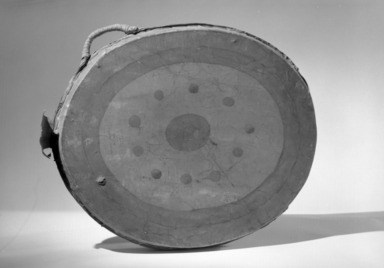
Artist:Great LakesSioux
Medium: Hide, wood, pigment
Geograhical Locations:
Dates:early 19th century
Dimensions: 19 7/8 x 2 1/2 x 16 1/8 in. (50.5 x 6.4 x 41 cm)
Collections:
Accession Number: 50.67.81
Image: 50.67.81_acetate_bw.jpg,
Catalogue Description: Double-headed, shallow drum is made of skin stretched over a frame. The hide surface is laced closed. A projection of stiff rawhide from the top of the drum is now mostly missing. However, the Fort Snelling military officer and artist, Seth Eastman, drew this particular example, showing that this projection originally represented a bird, possibly a thunderbird. The handle is on the right side if the drum is held upright, as shown in the Eastman sketch. There are native repairs on the reverse. The painted design on one side is now brown with darker outlining. Original notes made by Larson on the Eastman sketch list concentric circles from the outside in: "red, deep yellow and yellowish." In addition, the central and largest ovoid field, formerly yellowish and now simply lighter in color, is painted with a smaller brownish (formerly red?) ovoid at the center. This form in turn is surrounded by even smaller circles or dots on the palest ovoid filed, which may have once been yellow and red.